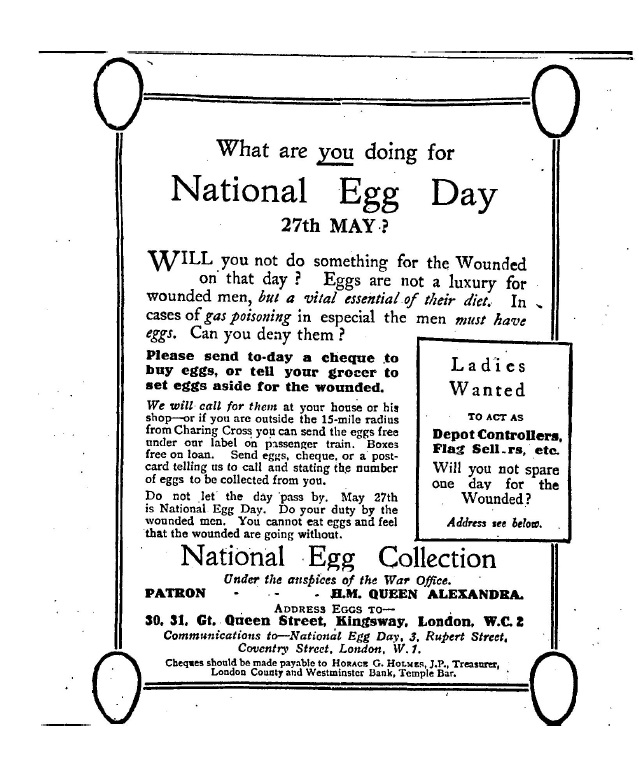On 27 May, exactly 100 years ago, it was National Egg Day. Now we are used to the regular occurrence of such obscure, trivial celebrations on Twitter (I honoured National Limerick Day in my last blog). But this was an era long before social media. So why raise a toast to eggs on 27 May 1918?
The Times advert for National Egg Day implored its readers to ‘send eggs’ to the wounded. ‘In cases of gas poisoning in especial the men must have eggs. Can you deny them?’

The promotion of ‘eggs for the soldiers’, as one slogan ran, began in 1914 with the National Egg Collection campaign, following a proposal from editor of the magazine Poultry World (still in print!). Over 41 million eggs had been collected by the end of the campaign in 1919.
But it is unclear why the War Office considered eggs especially essential for victims of poison gas.
Poison gas became the greatest fear among soldiers fighting in the Great War. On 22 April 1915 the German Army deployed 168 tons of liquid chlorine at the battle of Ypres, the resulting yellow gas cloud asphyxiating thousands of soldiers within minutes. It was the first instance of mass killing by a chemical agent.
Gas masks were quickly developed in response. The earliest kind, issued to the British within 36 hours of the Ypres attack, was simply a gauge veil containing cotton soaked in a solution of sodium thiosulphate, washing soda and glycerine, which protected against low concentrations of chlorine.

In January 1916 the ‘PH’ gas helmet was launched to combat the introduction of a new odourless, clear and deadly gas: phosgene. The PH stood for phenate-hexamine, a chemical solution effective at neutralising the gas. Phosgene was responsibility for 85% of all gas deaths in the First World War.
To warn against gases that carried no odour or colour in the trenches, gas alert rattles were employed, giving troops time to adorn their protective clothing. Rattles like these would later be adopted by fans in football grounds.

Gas warfare led to the establishment of Porton Down, the Government’s laboratory for research in biological and chemical weapons defence, which began as the War Department Experimental Ground in January 1916. The Science Museum recently acquired Porton’s archive.
As well as Porton, research on chemical weapons was also carried out at Imperial College, the Museum’s next-door neighbours in South Kensington. The Ministry of Munitions had assumed control of the chemistry department in 1914.
Two trenches were built behind the chemistry department to simulate conditions on the Western Front. Leading an all-female chemical warfare team at Imperial was Martha Whiteley (1866-1956), whose distinguished career, the excellent Patricia Fara notes in her recent book, was unique for a female chemist in the early 20th century.

Alongside chlorine and phosgene, mustard gas was one of the most-used chemical weapons during the war. It was less deadly than the other two, but more debilitating, causing horrendous burns. Whiteley heroically experimented with the first sample of this then-unidentified gas after its first use in 1917.
‘I naturally tested this property by applying a tiny smear to my arm and for nearly three months suffered great discomfort from the widespread open wound it caused in the bend of the elbow’.
Whiteley also developed a tear gas that was named ‘SK’ for South Kensington. The British press celebrated her achievement with the line: ‘the woman who makes the Germans weep’.
Her war work was recognised in 1920 with an OBE. She would become an influential campaigner for women in chemistry. It is not known whether Whiteley celebrated National Egg Day.
See a range of gas marks, the anti-gas rattle and many more First World War objects in the free exhibition Wounded: Conflict, Casualties and Care, closing Sunday 3 June.
